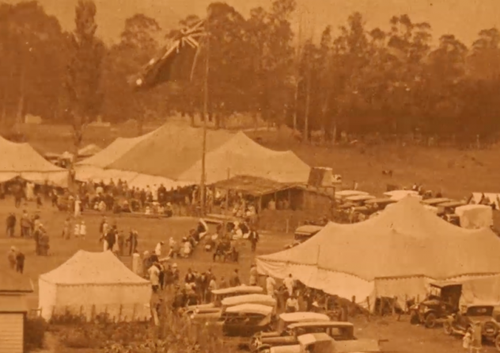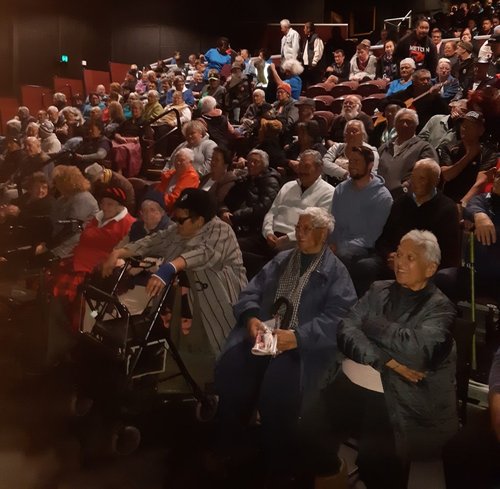
By Lawrence Wharerau
This has seen Ngā Taonga, and its previous entity the New Zealand Film Archive, presenting archival film from the East Coast region to groups of kaumātua every few years.
This September we were able to return again after liaising with Tūranga Health coordinator Kay Robin. Anecdotal information and context to complement the screening was provided by Ngā Taonga Senior Outreach and Engagement Curator Māori Specialist, Lawrence Wharerau.
This screening was a wonderful opportunity to highlight the collections of Ngā Taonga to wide and diverse communities and especially our aged communities, who may have a closer connection to the images presented.
Supported by Te Rūnanga o Ngāti Porou, the earliest film shown dates back to April 1919 with Hui Aroha ki Tūranga. This is a visual record of the hui at Te Hapara near the current day Te Wānanga o Aotearoa and the Gisborne Race Course. The gathering had a number of purposes: there was the unveiling of the memorial to Wi Pere; it welcomed soldiers back from World War One and honored those who fell during the war; and it recognised those who suffered from the terrible 1918 influenza epidemic that accompanied the returning soldiers. Read the original pānui notification and invitation to the hui.

Kaumātua at the Tūranga Health screening in Tūranganui-a-kiwa Gisborne
Photo by Lawrence Wharerau.
He Pito Whakaatu a te noho o te Māori i Te Tai Rāwhiti: Scenes of Māori Life on the East Coast from 1923 recorded the ethnographic expedition by the Dominion Museum to record aspects of traditional Māori life. In the 1920s, with the effects of World War One, dislocation and dispossession of land and the flu epidemic, Māori were believed to be a dying race. The excursion was led by Apirana Ngata, Minister of Native Affairs; Te Rangihīroa Peter Buck, Minister of Health; Elsdon Best, ethnographer for the Dominion Museum; and Johannes Anderson, Head Librarian at the Alexander Turnbull Library.
On 16 February 1926 cameras were present at the consecration of the second St Mary’s Church on the rise at Tikitiki and the hui is recorded in the film Māori Hui at Tikitiki. When this film first came into our collections, little was known about the occasion, location and who was depicted in the images. During a presentation at the National Library in the early 1990s – where our organisation is now based – a kuia from Ngāti Porou identified the marae. She particulary recognised the wharehui Rongomaianiwaniwa by its distinctive carvings of exotic animals on the maihi barge boards. Further sleuthing confirmed this is indeed a record of that auspicious occasion – the Governor General Sir Charles Ferguson attended along with an official entourage and thousands of other attendees.
“All three of these silent films have been preserved and conserved by Ngā Taonga over the past four years, and we are always proud and hugely honoured to share them with whānau, hapū and iwi who have a direct connection to the images,” said Wharerau.
There was a brief intermission, like in the old days, before moving into the sound section of the screening.
Items in the sound section included Weekly Review 458: Funeral of Sir Apirana Ngata from July 1950. It shows the outpouring of aroha for the colossal elder statesman in Māori politics that Sir Apirana Ngata was and still is. His funeral was attended by senior government ministers, including Prime Minister of the day Sidney Holland and Minister of Māori Affairs Ernest Corbett, as well as iwi from around the country. A bust of Sir Api was presented to his marae at Waiomatatini and it now graces the halls of Parliament House.
Another film shared with Tūranga kaumātua was Ringatū Centennial hui Muriwai. Shot at Muriwai near Young Nick’s Head during the centennary commemoration of the establishment of the Ringatū faith, it looks at the history of Muriwai and the Māori presence in the area. It discusses attempts to reconcile Māori spirituality with Christianity. It shows the marae and preparations for the hui, the arrival of Governor General Sir Arthur Porritt and various dignitaries, as well as the wero as they enter the marae grounds.
Closing the screening event was the Pacific Films title From Where the Spirit Calls, a documentary on the restoration of two historic wharenui: Rongopai at Waituhi and Rukupō at Manutuke. It shows the outstanding decoration, which characterises these meeting houses that were carved in the 1870s – much of these details were hidden beneath multiple layers of paint. It also discusses the importance of wharenui in contemporary Māori society. The process to restore the wharenui is shown taking place with advice and encouragement from kaumātua of the marae and Māori Art Specialists Para Matchitt and the late Cliff Whiting. After hearing about the restorative mahi in Gisborne, another group from Tūai near Waikaremoana bring panels to be cleaned and repainted according to their original colours.
The free screening at Lawson Fields Theatre, promoted only by word of mouth, was attended by 140 kaumātua, 90 students from local Gisborne schools and a dozen or so interested walk-in members of the public. The audience also included a number of successful Kaumātua Olympic competitors guests of honour.
E ngā iwi o Te Tūranganui-a-Kiwa me te rohe o Te Tai Rāwhiti ka nui ngā mihi kau ana ki a koutou katoa, tēnā koutou, tēnā koutou, kia ora huihui mai anō tātou katoa.
Hero image: screengrab from Māori Hui at Tikitiki.